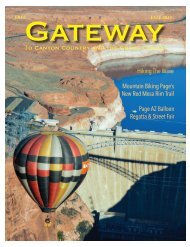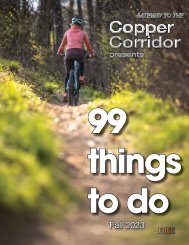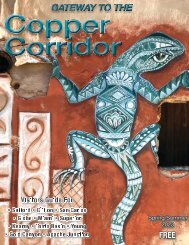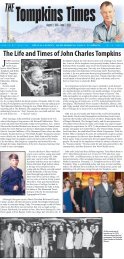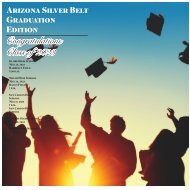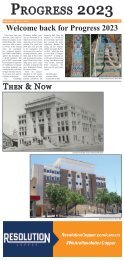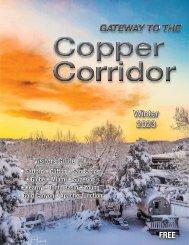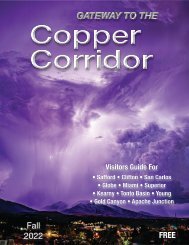You also want an ePaper? Increase the reach of your titles
YUMPU automatically turns print PDFs into web optimized ePapers that Google loves.
Looking Back: Picturing t he trail<br />
BY DAVID SOWDERS<br />
Assistant Editor<br />
Making their way<br />
over the Apache<br />
Trail, the travelers<br />
declared Roosevelt Dam<br />
“a very marvelous piece of<br />
work.” Their next stop was<br />
the “little mining town” of<br />
Globe, then to Phoenix and<br />
California – “A wonderful<br />
trip.” Somewhere along the<br />
way they bought a souvenir<br />
postcard of the Trail, mailing<br />
it to a relative or friend<br />
back east.<br />
It was mid-November<br />
1927; the Apache Trail was<br />
22 years old and the Globe<br />
& Bowie Railroad, aboard<br />
which their postcard was<br />
mailed, had been around for<br />
more than 30. But the card<br />
is also part of the story of an<br />
immigrant who made it big.<br />
Curt Teich was 19 when<br />
he came to the United States<br />
from his native town in<br />
Thuringia, now part of Germany.<br />
Coming from a long<br />
line of printers and publishers,<br />
he had worked as an apprentice<br />
printer. Teich landed<br />
in New York City in 1895,<br />
going to work as a printer’s<br />
devil. He soon moved on to<br />
Chicago, where the company<br />
he founded became the<br />
world’s largest printer of scenic<br />
postcards – like the one<br />
the travelers sent in 1927, depicting<br />
the Apache Trail and<br />
Superstition Mountain.<br />
The Apache Trail, initial-<br />
David Sowders/Copper Corridor<br />
Superstition Mountain and the Apache Trail, as seen on a vintage<br />
Curt Teich postcard<br />
ly called the Tonto Wagon<br />
Road, was built as a supply<br />
road to the Roosevelt Dam<br />
construction site. The road<br />
follows the course of a Native<br />
American foot trail. With<br />
Apaches providing much of<br />
the labor, it was finished on<br />
Sept. 3, 1905. After the trail’s<br />
completion, the Southern Pacific<br />
Railway Company started<br />
offering side trips down<br />
the scenic road to the dam.<br />
Around this time, Curt<br />
Teich brought a German<br />
postcard style to the United<br />
States, launching the colorful,<br />
large-lettered “Greetings<br />
From” cards that would become<br />
so well-known. Teich<br />
based them on the German<br />
“Gruss Aus” cards that started<br />
appearing in the 1890s.<br />
His firm, Curt Teich & Company,<br />
was also a pioneer in<br />
offset printing, which they<br />
started using in 1910.<br />
In 1905, as the Apache<br />
Trail was nearing completion,<br />
Teich crossed the country by<br />
train. Carrying a camera, he<br />
took photos of numerous<br />
small-town businesses along<br />
the way. From these pictures,<br />
he made his first sizable print<br />
run.<br />
“The frontier has passed,<br />
the cattle are vanishing, the<br />
west is changed,” wrote<br />
famed author Zane Grey in<br />
a Sept. 1927 letter to the Coconino<br />
Sun newspaper,<br />
published by the Sun the<br />
same month our travelers<br />
visited Roosevelt Dam and<br />
Globe.<br />
In November 1927, the<br />
Phelps Dodge mine at Morenci<br />
was producing an average<br />
of 3.75 million pounds of<br />
copper a month, but mining<br />
could still be dangerous<br />
work. In Superior, five men<br />
lost their lives in a fire at the<br />
Magma Mine; crews from<br />
the Globe and Miami mines<br />
helped battle the fire. On<br />
November 24, Globe High<br />
School ended its football season<br />
with a “fiercely fought”<br />
6-6 tie against Safford.<br />
During his 1905 trip, Teich<br />
personally took $30,000<br />
worth of postcard orders<br />
during this cross-country<br />
journey. As the company<br />
grew, he would employ hundreds<br />
of traveling salesmen/<br />
photographers. These men<br />
not only sold postcards to<br />
homes and worked with<br />
businesses to create advertising<br />
cards, but also took<br />
the pictures. Like the Apache<br />
Trail postcard – printed under<br />
the company’s C.T. American<br />
Art line – a number<br />
of pictures depicted scenes<br />
in Arizona, including the<br />
Globe-Miami area.<br />
In June 1928, Curt Teich<br />
& Company records show, a<br />
man named Henry (or Harry)<br />
Herz ordered a number<br />
of postcards featuring scenes<br />
around Globe and Miami;<br />
designs included the Gila<br />
County Courthouse, Bullion<br />
Plaza School, Broad Street,<br />
Sullivan Street, the Southern<br />
Pacific Depot and the Claypool<br />
Tunnel.<br />
Curt Teich & Company<br />
remained in business until<br />
1978, closing shop around<br />
four years after the passing of<br />
its founder. The Apache Trail<br />
remains, though much of that<br />
scenic road is now impassable<br />
due to fire-related flood<br />
damage in the last few years.<br />
<strong>Gateway</strong> to the Copper Corridor <strong>2022</strong><br />
15





